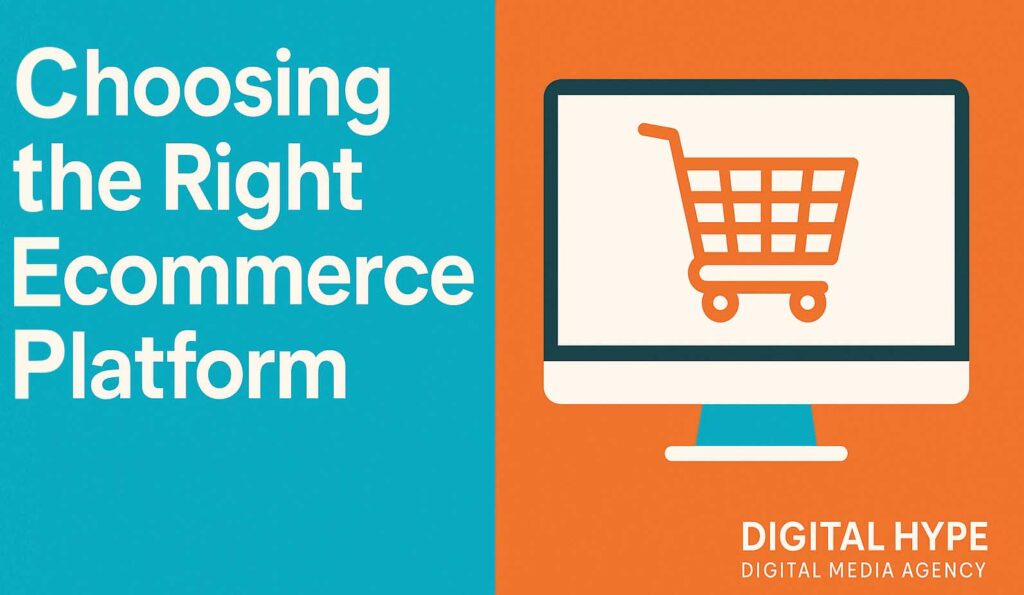Over the years, I’ve had countless conversations with business owners who tell me the same thing: “We’re thinking of building our own ecommerce system — it’ll give us more control.”
And each time, I find myself giving the same warning. I’ve seen too many companies pour tens of thousands into bespoke builds, only to find themselves trapped in a cycle of bugs, spiralling maintenance fees, and ultimately a costly rebuild.
The truth is, platforms like WooCommerce, Shopify, Magento, and OpenCart already solve 95% of what businesses need. They’re maintained by huge developer communities, updated constantly, and designed to grow with you.
So how do you decide which one is right for your business? Let’s break it down.
What Really Matters When Choosing an Ecommerce Platform
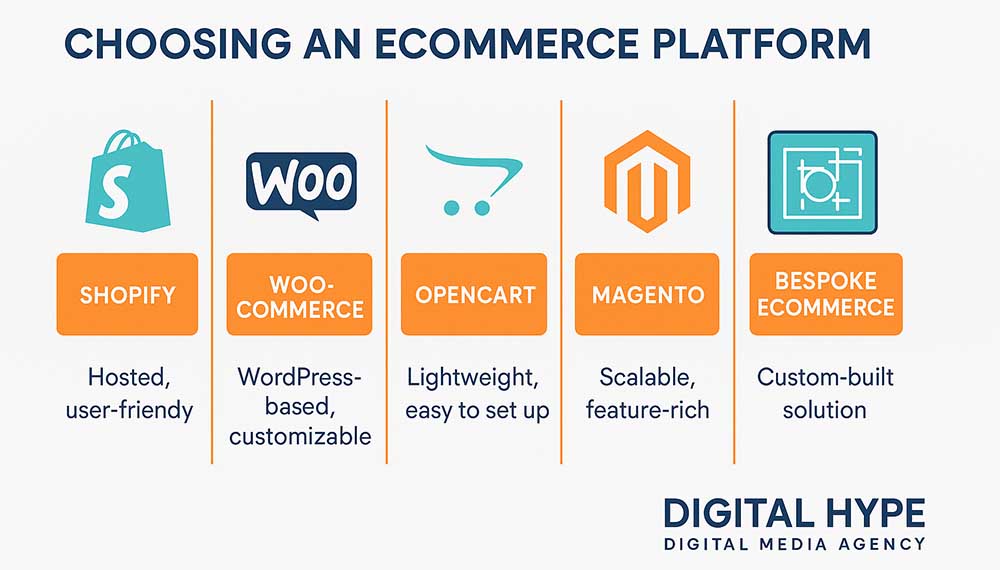
When I’m advising clients, I always encourage them to look beyond flashy features and ask the bigger questions:
- Scalability → Will this platform grow with you, or will it force a migration in two years?
- Marketing & SEO → Can it integrate seamlessly with Google, social ads, and email campaigns?
- Cost of ownership → What will it cost not just to start, but to run, maintain, and expand long term?
- Security & compliance → Will it keep customer data safe and satisfy regulations like GDPR?
- Ecosystem & support → If something breaks, can you find help quickly without relying on one developer?
Keeping those points in mind makes the choice far clearer.
WooCommerce: Flexible & WordPress Native
If your business is already running a WordPress site, WooCommerce often feels like the natural next step. I’ve seen plenty of SMEs who just wanted to dip a toe into ecommerce bolt WooCommerce on, and suddenly they’re trading online within weeks.
The freedom is fantastic, it’s open source, and the SEO benefits of WordPress carry straight across. But freedom comes with responsibility. I’ve lost count of the times I’ve been called in because someone installed 25 plugins without thinking, and now the checkout takes 12 seconds to load.
My take: WooCommerce is brilliant for SMEs and startups who want control, but only if you’re prepared to keep the house tidy. Think of it as buying your own shop outright — you can design the windows however you like, but you also need to fix the leaky roof.
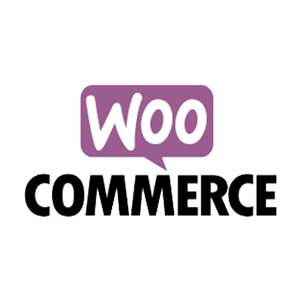
- Why it works: It’s free to install, SEO-friendly, and offers thousands of plugins.
- Where it trips people up: Hosting needs to be robust, and too many plugins can cause performance issues.
- Best suited for: Startups and SMEs already on WordPress who want low costs and control.
Think of WooCommerce as buying your own shop outright. You get the keys and the freedom, but you’re also responsible for fixing the roof when it leaks.
If you’re starting from scratch and want to combine a strong site design with ecommerce, our ecommerce development services can help you build a WordPress-based store designed to grow with you.
Shopify: Simplicity & Speed to Market
Whenever I work with non-technical teams, I almost always steer them towards Shopify. Why? Because it just works. I once worked with a startup that launched its entire store in less than a week. That would have been impossible with Magento or WooCommerce without serious developer time.
The flipside is that you’re renting the shop, not owning it. Shopify makes life easy, but you’re paying ongoing fees, and you don’t have the same level of freedom to customise. I’ve had clients get frustrated that they can’t “just” adjust the checkout flow without paying extra or hitting limits.
My take: The Shopify platform is the safest bet if speed and stability trump everything else. It’s like moving into a brand-new retail unit with security, utilities, and Wi-Fi already included. You just bring your stock.

- Why it works: Hosted, reliable, and integrates directly with major ad platforms.
- The flipside: You’re tied into ongoing subscription fees and transaction costs, and flexibility is limited compared to open-source.
- Best suited for: Businesses prioritising speed, simplicity, and minimal maintenance.
It’s like renting a ready-to-go retail unit. You don’t own the walls, but you can move in and start selling straight away.
Magento (Adobe Commerce): Enterprise Power
Magento (now owned by Adobe) stands alone in its own league. I worked with a corporate retailer rolling out across Europe, and the complexity of currencies, languages, and tax rules would have broken most systems. Magento handled it, but at a price.
This isn’t a platform you dabble in. You’ll need specialist developers on call and a budget that stretches well beyond “small business.” I’ve seen teams underestimate this and get buried in ongoing support bills.
My take: Adobe Magento is like owning a fleet of juggernauts. Fantastic if you’re hauling across continents, ridiculous if you’re just delivering around town. For most SMEs, it’s complete overkill.
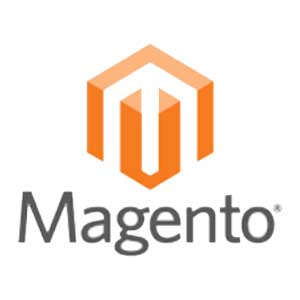
- Why it works: Hugely scalable, flexible, and built for enterprise.
- The catch: Expensive to build, expensive to maintain, and requires specialist developers.
- Best suited for: Corporates and large retailers with complex, multi-country operations.
For SMEs, it’s overkill. Running Magento without the right team is like trying to drive a Formula 1 car down Bournemouth High Street, technically possible, but completely impractical.
OpenCart: Lightweight & Straightforward
OpenCart is the underdog. I’ve seen it appeal to businesses that don’t want monthly subscriptions draining their cash flow. It’s lean, it’s free, and you can be up and running quickly.
But it’s also bare bones compared to the bigger players. You don’t get the huge app ecosystems or armies of developers, which can bite when you hit a growth spurt.
My take: The OpenCart ecommerce platform works best for smaller shops that want something functional and affordable, without bells and whistles. It’s the equivalent of a tidy market stall rather than a high-street superstore.

- Why it works: Free to acquire, simple admin, no subscription fees.
- The catch: Limited ecosystem and fewer developers compared to bigger platforms.
- Best suited for: SMEs wanting a cost-effective, straightforward ecommerce solution.
It’s the tidy market stall compared to the full high-street store.
Bespoke Ecommerce Builds: The Trap
This is the conversation I dread having with clients, because I’ve seen the fallout first-hand. One retailer I worked with spent £40,000 on a bespoke system. Two years later, they came back, sheepishly, because the system couldn’t scale. They rebuilt the whole thing on Magento. Essentially, they paid double for the same journey.
Yes, bespoke builds promise total control. But in reality, they lock you into one developer, with no community or ecosystem to support you. When that developer disappears, you’re stuck.
My take: Bespoke ecommerce is like commissioning a one-off car. It looks unique, but every repair costs a fortune, and no garage seems to know how to fix it. Unless your business model is genuinely unlike anything else out there, don’t go near it.
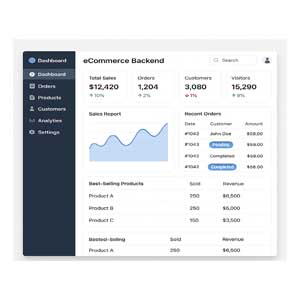
- The lure: Total control and “unique” features.
- The reality: High upfront costs, dependence on one developer, and little flexibility.
- Best suited for: Almost no one, unless your business model is genuinely unique.
Bespoke is like commissioning a one-off car. It looks impressive, but every breakdown is costly, and no one else knows how to repair it.
Need an ecommerce site that drives more sales?
Our Ecommerce Web Design experts create tailored solutions that focus on performance, scalability, and results for your business.
Start Your Ecommerce ProjectWhat It Really Costs
Here’s what I tell clients when we map out realistic budgets (excluding ad spend):
| Platform | Setup Costs | Ongoing Monthly Costs | Notes |
|---|---|---|---|
| WooCommerce | £2k–£5k | £200–£500 | Cost-effective if on WordPress |
| Shopify | £3k–£8k | £29–£299 + % of sales | Quick to launch, predictable costs |
| Magento Open | £15k–£30k | £500–£1.5k | Needs specialist developers |
| Magento Cloud | £30k–£50k+ | £1k–£3k + licence | Enterprise-level only |
| OpenCart | £2k–£6k | £150–£400 | Leaner option |
| Bespoke | £20k+ | £1k–£5k retainer | Rarely worth it long term |
Why Platforms Beat Bespoke Every Time
From my experience, platforms consistently win because:
- They’re updated constantly for security and compliance.
- They offer plug-and-play extensions at a fraction of bespoke cost.
- They have vast developer communities, so you’re never locked in.
- They spread development costs across millions of users, keeping them sustainable.
Bespoke might sound exciting, but the ongoing headaches usually kill the dream.
How Different Businesses Should Decide
- Startups & small businesses: WooCommerce, Shopify Basic, or OpenCart.
- SMEs: WooCommerce or Shopify Standard.
- Scaling SMEs: Shopify Advanced or Magento Open Source for catalogues and omnichannel.
- Corporates: Magento.
- Hobby projects: WooCommerce or Shopify Lite.
Ecommerce Platform Questions Business Owners Actually Ask
Choosing an ecommerce platform isn’t just about comparing features; it’s about matching the technology to how you actually run and grow your business. Over the years, I’ve been asked the same questions repeatedly by startups, SMEs, and corporations. Below, I’ve answered the queries that really matter, based on real-world challenges and what I’ve seen work (and fail) in practice.
Is WooCommerce really free?
Yes, the plugin is free — but you’ll still pay for quality hosting, a checkout/SEO stack, and someone to maintain updates. For teams already on WordPress, it’s usually the lowest total cost if you keep plugins lean and the site well-built. If you’re starting from scratch, consider pairing WooCommerce with a professionally built site via our Ecommerce Web Design team so performance isn’t an afterthought.
Which platform is best if we plan to run lots of paid ads?
Shopify is the easiest “switch-on and go” for Meta, Google, and TikTok ads. WooCommerce can match it with the right feed and pixel plugins, but it needs more setup. BigCommerce is strong when you’re feeding large catalogues across channels. If paid traffic is core to your plan, also see our Online Marketing support.
Can WooCommerce handle 20,000+ products?
Yes — with solid hosting, object caching, a sensible theme, and search indexing (e.g., Elastic/Solr/hosted search). Most performance “limits” are architectural, not platform. I’ve seen Woo stores handle 20k–50k SKUs smoothly once the stack is tuned.
Is Magento overkill for most SMEs?
Usually. If you’re not dealing with multi-country pricing, complex B2B rules, or heavy custom workflows, Magento’s cost and care requirements are hard to justify. Signs you might need it: multiple warehouses, advanced B2B (quotes, account pricing), and strict integration with ERP at scale.
Is a bespoke ecommerce build ever worth it?
Only when your business model truly can’t be mapped to existing platforms. The hidden cost isn’t the build, it’s years of maintenance, security, and feature parity. A rule of thumb: if 80–90% of your needs exist in a mainstream platform plus extensions, don’t go bespoke.
Which platform gives the best long-term value?
WooCommerce / OpenCart: lowest ongoing costs if you keep things lean and maintain well.
Shopify / BigCommerce: predictable fees, fewer “surprise” dev bills.
Magento: high cost, high capability — worth it only when complexity demands it.
How quickly can we launch on each platform?
Shopify: days to a few weeks (theme + content + apps).
WooCommerce: 3–8 weeks depending on design and integrations.
BigCommerce: 4–8 weeks, longer with headless.
Magento: months — treat as an enterprise programme.
Tight on time? Start with Shopify or a lean WooCommerce build, then iterate.
What about international selling (currencies, VAT, languages)?
Magento: best-in-class for multi-store, multi-currency, complex tax.
BigCommerce: strong internationalisation with less overhead.
Shopify/WooCommerce: absolutely fine for most exporters; just plan your tax, duties, and translations up front.
Whichever you choose, make VAT, shipping rules, and hreflang a first-class requirement, not an add-on.
Will we own our data and avoid vendor lock-in?
WooCommerce/OpenCart/Magento (open source): you own code and database; easy to move hosts.
Shopify/BigCommerce: you own your data, but the platform and checkout are proprietary. Exports are possible, but migration takes planning.
If ownership matters, prioritise open-source or keep your data layer clean and well-documented.
Can we integrate POS, inventory, or ERP (Xero, Unleashed, SAP, Netsuite)?
Yes on all major platforms, the question is how much customisation. Shopify and BigCommerce have strong off-the-shelf connectors. WooCommerce integrates well with the right middleware. Magento handles deep, custom ERP logic, at enterprise cost. Budget for integration mapping and testing, not just licences.
Which platform is best for SEO and Core Web Vitals?
WooCommerce: granular control and great content workflows via WordPress — ideal if SEO is central.
Shopify/BigCommerce: fast, stable baselines; some technical limits, but perfectly capable.
Magento: powerful but easy to over-engineer; stay performance-disciplined.
If search is a growth channel, align platform choice with your content and technical plan — and consider our SEO services to set the site up right.
Do these platforms handle subscriptions, memberships, or B2B pricing?
Subscriptions/Memberships: easy on Shopify (apps) and WooCommerce (extensions); possible on BigCommerce; native and custom on Magento.
B2B (quotes, account pricing, minimums): best on Magento and BigCommerce; achievable on WooCommerce/Shopify with the right stack.
What should we really budget (beyond licences)?
Plan for: design/build, payment fees, apps/plugins, hosting, security, backups/updates, CDN, search, analytics, and a monthly care plan. A realistic SME range is £200–£600/month for Woo/BigC basics (ex-ads), or £29–£299/month plus app fees on Shopify, then layer paid media and content on top. If you want a build that stays fast and conversion-focused, get it specified properly via our Ecommerce web developers.
When should we replatform?
Common triggers: your catalogue or order volume outgrows performance, you’re blocked by missing features, integrations become brittle, or total cost of ownership keeps rising without payoff. If two or more are true, it’s time to scope a move, and to ring-fence migration, SEO, and data-cleaning from day one.
How do we protect customers and stay compliant (GDPR, PCI, SCA)?
Use reputable gateways (Stripe/PayPal/Apple Pay/Google Pay), enable 3-D Secure/SCA, keep platforms and plugins up-to-date, and limit data you store. Hosted platforms reduce PCI scope; open-source gives control but demands good ops. Document processes, not just tech.
Should we go headless?
Only if you have genuine reasons: multiple front-ends (apps, kiosks), complex content needs, or performance demands at scale. Headless adds cost and team complexity; it’s brilliant for some, unnecessary for many.
Can we start simple and upgrade later?
Yes — and it’s often the smartest route. Launch lean on Shopify or WooCommerce, validate your offers, then invest in deeper integrations, custom UX, and automation as revenue grows.
What’s the one mistake you see most often?
Choosing a platform on “feature lists” rather than how you’ll market, operate, and maintain it. The winners align platform, content, ads, and operations from the start. If you want help getting that alignment right, talk to our web design team, we build with growth in mind.
Choose for Growth, Not Ego
I’ve seen businesses thrive on WooCommerce and Shopify, scale successfully with BigCommerce, and dominate international markets with Magento. I’ve also seen too many waste fortunes on bespoke builds that collapsed under their own weight.
The takeaway? Choose a platform that fits your business today but has the capacity to grow with you. Whether you’re a small retailer in Bournemouth or a corporate rolling out across Europe, the right platform will give you scalability, flexibility, and peace of mind, without reinventing the wheel.
Looking to build or redesign your ecommerce site?
Our Ecommerce Web Design team at Digital Hype specialise in creating ecommerce solutions that don’t just look great but deliver real results.
Explore Ecommerce Web Design
